After three years with the Razer Viper Ultimate (RVU) as its flagship, Razer has finally taken the covers off its replacement, the Viper V2 Pro. The refreshed device looks a lot like its predecessor from a distance. But, as soon as you pick it up, you’ll see Razer created a very different beast this time around. Gone are the rubber side grips and 16 grams of weight, leaving behind Razer’s most uncompromised attempt at creating a lightweight, purpose-built tool for the serious, competitive gamer interested in one thing: winning.
So, why has a mouse that seemingly made all of the right moves become something of a controversy? One big reason: its price.
More specifically, a widely-held, not very nuanced belief that Razer’s asking gamers to “pay more for less” by pricing the lighter, less feature-rich Viper V2 Pro at the same $150 launch price its more broadly-equipped ancestor launched at. The reality of V2 Pro’s value proposition is far more complex
Still, this brewing argument from what appears to be a vocal minority threatens to prevent buyers from clearly seeing what is almost certainly the best mouse to launch so far this year. Let’s take a thoughtful look at both the Viper V2 Pro’s performance and at how ongoing debates about its pricing hold up on closer inspection.
Like
- Lightweight without holes or feeling flimsy
- Redesigned feet glide more smoothly, even on soft pads
- In-game performance matches or beats anything else on the market
- Optional side grips provide best of both worlds
Don’t Like
- Charging setup just isn’t as convenient as the Viper Ultimate’s dock system
- Takes a second or two to wake after entering standby
Specifications
|
Connectivity |
Razer HyperSpeed 2.4GHz wireless |
|
Battery life |
Up to 80 hours (at 1,000Hz polling rate) |
|
RGB lighting |
none |
|
Sensor |
Razer Focus Pro 30K Optical |
|
Programmable buttons |
5 |
|
Switch model |
Razer Optical Mouse Switches Gen-3 |
|
Mouse feet material |
100% pure PTFE |
|
Size and weight |
126.7mm long x 57.6mm wide (at grip) x 37.8mm tall | 58g |
Shape
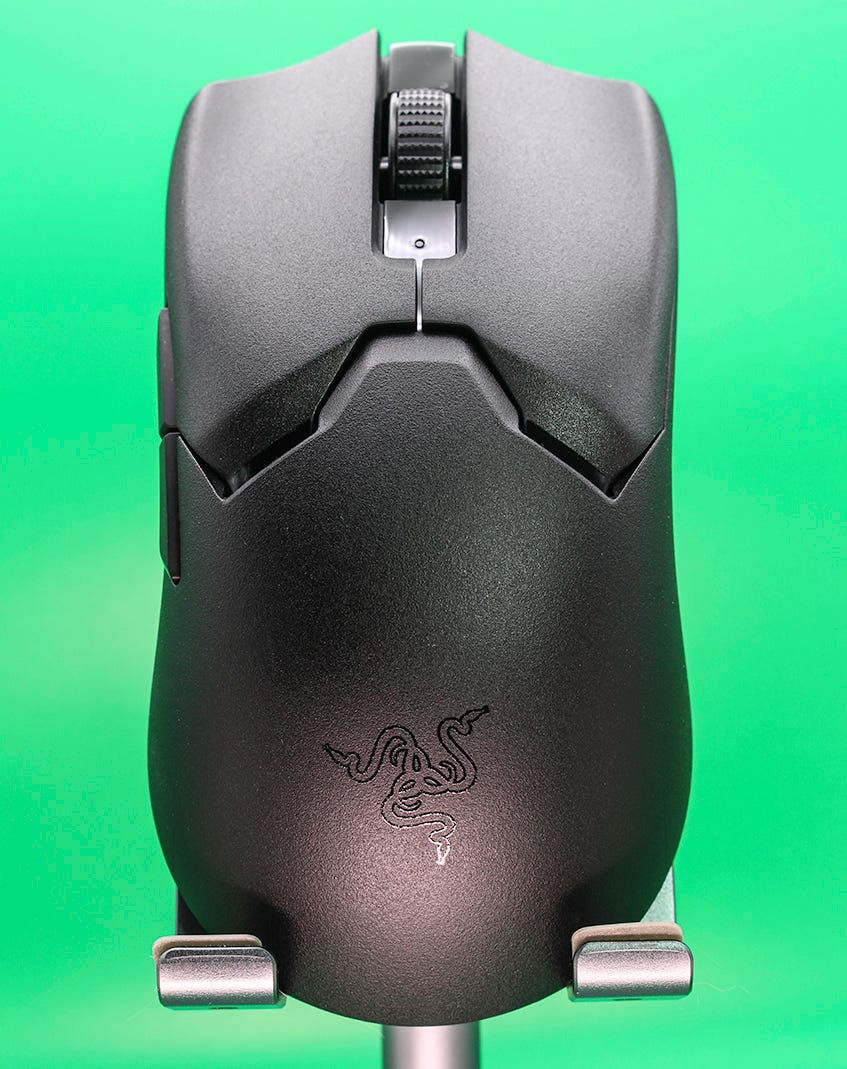
Michael Gariffo
This is an easy one. The Viper V2 Pro is identical to the Viper Ultimate in shape and size. However, there are a few major changes to the exterior, all of which address the issues I, and many other reviewers, have highlighted as improvements the Viper line could benefit from. It seems Razer was listening.
First, the company removed the rubber side grips in favor of an all-plastic design. I enjoyed the texture provided by the built-in rubber panels on the RVU, but many users complained they’d wear away over time. Since they couldn’t be replaced, many mice that were otherwise perfectly functional met an early end.

Left: Razer Viper Ultimate in Mercury White, sporting its permanent rubber side grips. Right: The Razer Viper V2 Pro with hard plastic sides.
Michael Gariffo
The texture on the V2 pro closely matches the recently-released Orochi V2, more so than the RVU. It provides excellent grip and offers enough friction to provide a stable presence in the hand, even on hot and sweaty days.
Luckily, if you still prefer the feel of softer rubber, Razer has provided a set of rubber grips that can be applied to the V2 Pro. These appliques are replaceable, meaning no more Vipers will need to be tossed out due exclusively to worn grips. The provided grips cover the side panels and left and right mouse buttons, with cutouts on the left side for the back/forward buttons.

The included rubber grips
Michael Gariffo
You’ll note I specified those cutouts are only on the left. That’s because the V2 Pro no longer includes buttons on its right panel. Where the RVU was a “true” ambidextrous mouse, offering back/forward buttons on both sides, the V2 Pro offers them on the left only.

Left: RVU with its right-side buttons. Right: the buttonless Viper V2 Pro
Michael Gariffo
This might disappoint left-handed mouse users, but it will be a godsend for those unlucky souls that constantly, accidentally actuated the right-side switches of their RVU due to their presence in a location where some gamers’ ring or pinky fingers fell.
I should also note that the left-side buttons are now more proud, protruding an extra millimeter or two when compared to the RVU. This should excite anyone that felt the predecessor’s side buttons were too flush to reach quickly.
More: Razer DeathAdder V2 review: A gaming mouse workhorse for serious gamers
Features

Michael Gariffo
Weight
The Viper V2 Pro weighs in at 58g. This puts it a full 16 grams lighter than the RVU (74g), and 5 grams lighter than its most obvious direct competitor from Logitech, the G Pro X Superlight (63g). It also means that it’s lighter than many popular wired mice, despite the added weight of an 80-hour battery.
Like the G Pro X Superlight, it manages to achieve this diminutive weight without resorting to the honeycomb shells or perforations that many mouse manufacturers use to drive down mass. We’ll discuss more about why this is very important a bit later on.
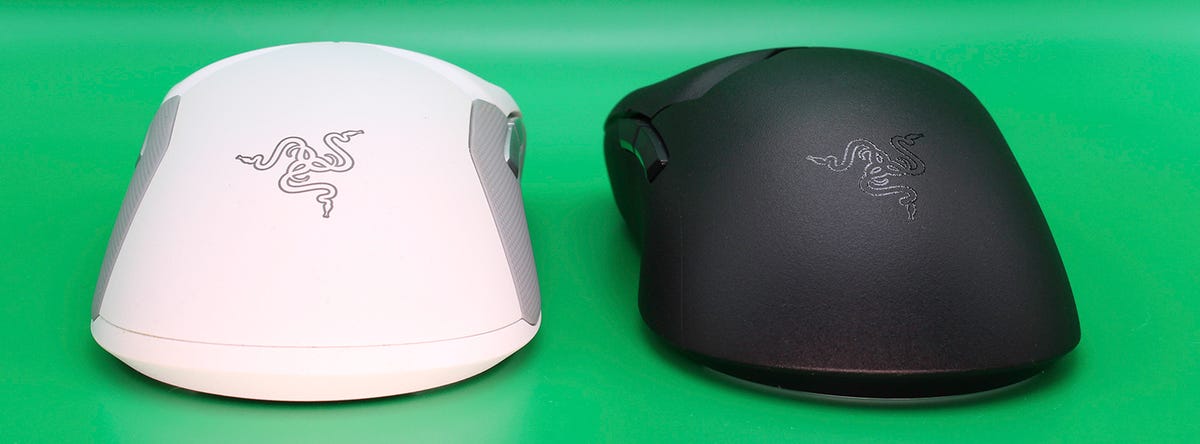
The logo on the RVU (left) allows for RGB shine-through lighting. The V2 Pro’s is printed on the shell.
Michael Gariffo
Lighting and buttons
At the risk of delving into clickbait territory…what you’re about to read next may shock you! The Viper V2 Pro, a Razer product, has no RGB lighting whatsoever. In its quest to bring down the weight and create a pure performance device, Razer skipped the RGB logo in favor of a simple printed logo.
More: HyperX QuadCast S review: Add some flair to your streaming setup
The only included lighting is a tiny LED located behind the scroll wheel. It illuminates to let you know the mouse is connected, as well as its charging status. The change might not sit well with RGB fanatics, but it was a necessary one to achieve that 58g weight.

From left to right: RVU in Mercury White, the Logitech G Pro X Superlight in Black, and the Viper V2 Pro in Black, with their respective side button placements.
Michael Gariffo
We’ve already discussed the lack of right-side buttons. The additional protrusion of the remaining left side buttons is welcome. While I didn’t struggle with the back/forward inputs on the RVU the way some folks seemed to, they did require a split second longer to reach than similar inputs on other gaming mice. It’s now easy to roll your thumb to actuate either with no thought or delay.
The actual tactility of the side buttons remains relatively unchanged. Like those on its predecessor, they have no noticeable pre-travel, and almost no post-travel, making for a responsive and confidence-inspiring experience, even during heated gameplay.
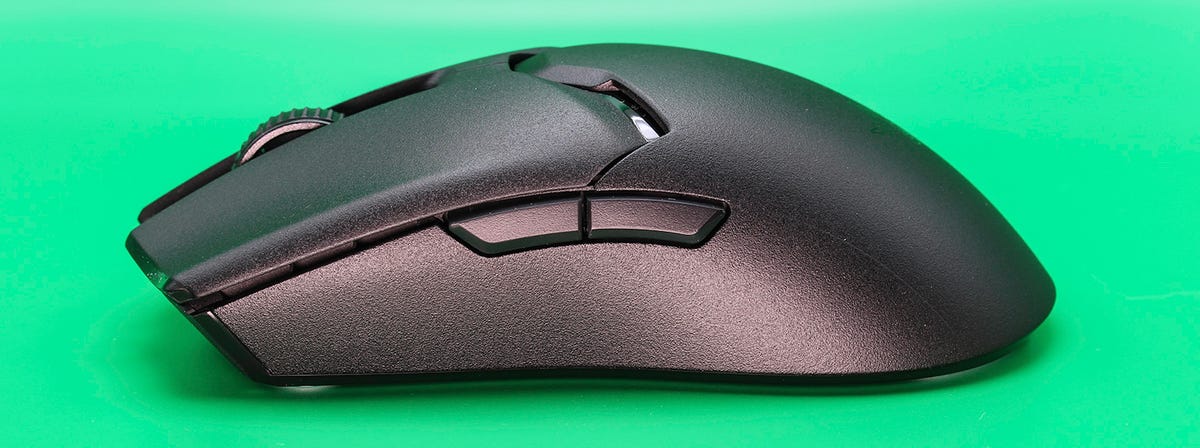
Michael Gariffo
The changes to the primary left and right mouse buttons are more dramatic. Razer once again updated its optical mouse switches.
Mechanical mouse switches from Omron, Kailh, and others, found in most mice, use metal contacts to actuate their function, much like their keyboard counterparts. Optical switches like Razer’s instead rely on tiny beams of light being interrupted when the button is pressed. The company claims this provides lower latency, faster response times, and longer lifespans — 90 million clicks, in this case.
More: Mechanical keyboards: A comprehensive guide
I’ve always found Razer’s optical switches fast and responsive. However, I, and many others, have often noted they never felt quite…right. Early on, there was a certain hollowness to the click that seemed less satisfying than mechanical switches, with less noticeable feedback. Razer made good progress correcting this weakness with its Gen 2 optical switches (found in later revisions of the RVU like the Mercury White edition seen throughout this review). But now, with its Gen 3 opticals, it’s closed that gap entirely.
The Gen 3 optical switches used in the left and right mouse buttons easily sound and feel just as good as the Omron models used in Logitech G Pro X Superlight. While they may not match the tactility and sound profile of some aftermarket switches, like TTC Goldens and Kailh’s 8.0 units, they come shockingly close.

The included charging and connection accessories: a USB-A to USB-C charging cable, 2.4GHz wireless dongle, and a coupler to connect the two when gaming in wireless mode.
Michael Gariffo
Connectivity and charging
This section will cover what’s probably the single most controversial change between the RVU and Viper V2 Pro generations: the dock.
The Razer Viper Ultimate launched with a charging dock packed in. You could purchase the mouse separately at a later date, but most still opted to acquire the charging dock. It’s understandable. The excellent little accessory allowed you to toss your RVU onto the charger whenever you weren’t using it, acted as a USB extender for the included wireless dongle, and even provided some extra RGB lighting. It could also charge other Razer mice that were released later on.
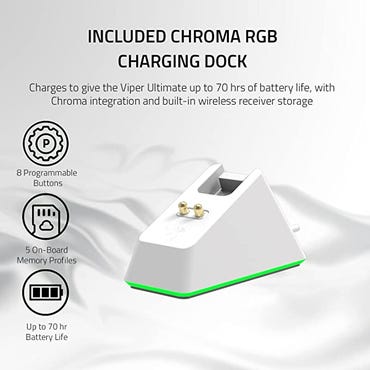
Razer — Amazon
The V2 Pro skips all of those things in favor of an increasingly-popular setup that nearly every gaming mouse maker is now using. That setup consists of a USB-A to USB-C charging cable, a coupler, and a 2.4GHz dongle. The dongle, in this case, uses Razer’s HyperSpeed Wireless technology to provide a 100% stable, connection that’s indiscernible from a wired mouse.
The idea is for the user to spend most of their time with the USB-A side plugged into their PC and the USB-C side plugged into one end of the coupler, with the wireless dongle in the other end. When the mouse needs its battery topped up, you unplug the USB-C connector from the coupler and plug it into the mouse, swapping to a wired data connection while the mouse charges. When it’s done, you simply reverse that process and go back to wireless.
More: The 5 best wireless mice: Cut the cord
This setup is relatively easy to use, extremely flexible, and basically the industry standard at this point. But, it can’t match the simplicity of dropping an RVU onto its dock. That fact has been the source of many complaints about Razer’s pricing of the V2 Pro. However, those complaints — as well as those about the lowered weight, missing RGB, and lack of right-side buttons — all stem from a fundamental misunderstanding of what Razer was trying to do here. We’ll discuss the truth of the situation in the “Performance” section in a moment.

Michael Gariffo
Sensor and feet
The Focus Pro 30K Optical Sensor in the Viper V2 Pro worked exactly as expected in my testing. It showed no unwanted acceleration or alteration of its tracking, suffered no spinouts or technical hiccups, and tracked equally well across cloth, hard, and glass mousepads.
It’s worth noting that Razer’s Synapse interface for the V2 Pro is a bit different. In the “Calibration” tab where the RVU could be calibrated to recognize a specific mousepad, there is new text saying “Your Razer gaming mouse delivers immensely accurate tracking straight out of the box. To experience another level of precision, set a tracking distance and use Asymmetric Cut-Off to dynamically adjust its lift-off and landing distance across every surface.”
More: The best gaming mouse pads: Elite mats for control and speed
While I never really found the RVU’s calibration to make much of a difference, the new ability to set “Low, Medium, or High” tracking distances definitely affected the lift-off distance (the distance from the mouse pad at which the sensor stops tracking) of the V2 Pro. Meanwhile, the Asymmetric Cut-Off mode allowed fine-tuning, making it possible to dial in the lift-off distance more precisely, regardless of your pad material.

The RVU’s smaller, more angular feet versus the Viper V2 Pro’s more rounded, larger trio
Michael Gariffo
The changes to the V2 Pro’s feet are much more impactful. The RVU was often called out for having not only some of the smallest feet of its generation of gaming mice, but some of the most sharply angled. Those 90-degree turns and relatively small surface area could create unwanted resistance on softer mousing surfaces. I added some aftermarket feet to my unit to lessen this exact issue.
I didn’t feel the urge to do anything similar to the V2 Pro. Its larger, singular rear foot and pill-shaped front feet glided easily out of the box, even on soft pads. They also have the same nicely rolled-over edges I praised in my recent reviews of the Steelseries Aerox 5 Wireless and Aerox 9 Wireless. Moving and stopping feel precise and nearly effortless. The redesigned feet, combined with the reduced weight, further amplified the sensation of the mouse being an extension of your arm.
More: SteelSeries Aerox 5 Wireless review: Can a mouse do too much? | SteelSeries Aerox 9 Wireless review: The best MMO/MOBA mouse you can buy
Although Razer lists the feet on the older RVU and newer V2 Pro as both being “100% PTFE” I noticed the newer feet have the pure white look of aftermarket PTFE skates, and feel slightly more “satin-y” to the touch, suggesting there was at least some change to the formulation there. If so, it was a positive one. Still, I wouldn’t have minded an extra set of feet included in the box.

The lower, flatter Viper shape (left and right) compared to the taller, rounder G Pro X Superlight (center)
Michael Gariffo
Performance
After a short adjustment period to once again get used to the multi-generational Razer Viper shape, I quickly found myself meeting or exceeding the accuracy of my recent personal mains: Logitech G Pro X Superlight and G303 Shroud Edition and the Razer Orochi V2.
Tracking consistently felt perfect when using automatic weapons like Halo Infinite’s assault rifle or beam weapons like Zarya’s or Symmetra’s primary fire in the recent Overwatch 2 beta. Flick shots with sniper rifles in both games also felt snappy, accurate, and correct. When I missed, I couldn’t delude myself into believing that it was the mouse’s fault, and was forced to place the blame squarely on my own skills.
If you’re a long-time user of the Viper family, the V2 Pro feels like its best evolution yet. It takes all of the high points of previous generations, sands off the few remaining rough edges, and leaves a well-tuned, laser-focused tool for aiming.
I compared Logitech’s G303 shroud edition to a sports car in my review of it. In its case, the analogy pointed to its shape being less-than-ideal for comfort, but excellent for accuracy. The comparison might be even more apt for the V2 Pro. But, instead of sacrificing comfort for accuracy, you’re sacrificing a few features from the previous generation for reduced weight.
More: The best gaming keyboards: All the hits and clicks
Just like a sports car that’s had its AC, radio, and interior fittings stripped out to improve its 0-60 times and handling, the Viper V2 Pro has had its RGB, dock connector, and right-side buttons removed to reduce weight. I am firmly in the school of thought that believes lighter is better for gaming mice, especially those aimed (heh) at FPS players. If you’re on the opposite side of that debate, you probably didn’t make it this far into the review because the V2 Pro was, to be blunt, not designed for you.
It’s these subtractions that are the center of the controversy surrounding the V2 Pro and its initial critical reception. Many Redditors have asked “Why am I paying more for a mouse that uses less plastic and doesn’t include a dock?” Some YouTube drama has even been stirred up by a rift between a few major mouse review channels, with one essentially calling any of the others that gave the V2 Pro a “glowing” review company shills.

The first part of Razer’s lengthy list of weight tweaks for this model
Razer
You are giving up a few things by opting for the V2 Pro. In fact, Razer actually lists most of them on its product page for the V2 Pro. As you scroll, you’re presented with an itemized list of what’s been removed and how much weight its absence saves. Built-in grips? -3.2g. Right side buttons? -2.9g. No RGB lighting? -2.7g.
The list goes on, but the point is this: there’s no deception here. Razer didn’t release a product that it claimed had every feature the RVU shipped with. What it actually released was a high-quality mouse that pragmatically sacrificed a few things in order to make it one of the lightest on the market…all without using a single visible perforation.
Side note: There are cleverly-hidden holes beneath the label and feet. If you’d like to see them, visit BeardedBob’s YouTube video on his efforts to make the V2 Pro even lighter. His channel is also a great resource on mouse modding in general.
The lack of visible holes in the outer shell is extremely important because it goes directly to explaining the cost. While there are plenty of other mice out there that are just as light as the V2 Pro, only a few have accomplished that weight without creating holes in their outer shell. You know what other mouse was ultra-lightweight, had no right side buttons, no RGB lighting, and included no dock? The G Pro X Superlight. Logitech launched it at $150, just like the Viper V2 Pro.
More: Logitech G Pro X Wireless vs Razer Viper Ultimate: Flagship gaming mice showdown
The fact is that creating mice this lightweight, without holes, and with the excellent structural integrity both models share is an expensive process. You’re not paying for the plastic that got injected into the mold when your mouse was made, you’re paying for the cost of the thousands of man-hours of engineering that went into creating a device that’s feather-light, accurate, and strong. The plastic costs pennies. The knowledge and technical development that goes into building it, well, that costs a hell of a lot more.
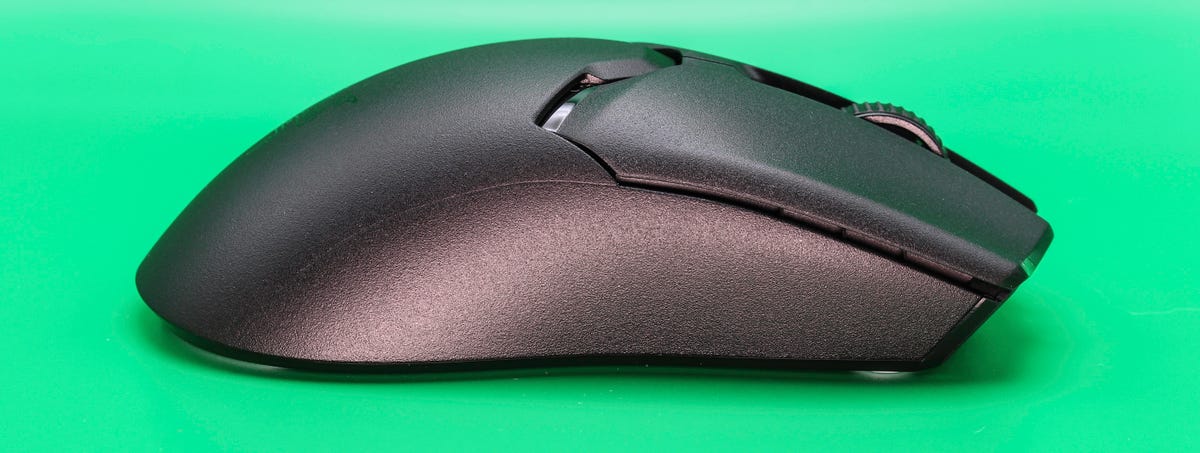
Michael Gariffo
Wrap up
To be clear, I’d have been downright giddy if the Razer Viper V2 Pro had launched at the $80-$100 price point that companies like Glorious, Pwnage, and Roccat are happy to inhabit. But, that was never a realistic expectation. The Glorious Model O Wireless leans heavily on perforations to achieve its heavier 69g weight. Meanwhile, Pwnage’s closest flagship (the Symm 2 Wireless) bottoms out at 71g even with holes across its sides and back, and Roccat’s Burst Pro Air, which does use a solid outer shell, weighs in at 81g.
All three of those models mentioned are great mice for the right user, but that user is not one that prioritizes low weight over everything else. It’s this exact demographic of gamer that Razer designed the Viper V2 Pro for.
For those that must have four side buttons, or believe their setup will suffer from removing any RGB lighting, Razer shows no signs of taking the RVU off the shelves. As mentioned, it’s a better deal than ever at $80. But, for FPS players seeking the best, most precise tool to help their headshot count or hand them more battle royale wins, the Viper V2 Pro is the best mouse Razer has ever produced.
More: The best cheap gaming PCs: Pro-level builds for less
I realize the $150 price point might price some users out of the running entirely. For them, I’d advise patience. Even the G Pro X Superlight, which remained sold out everywhere for months at $150, eventually saw its price reliably drop to $125. Razer has historically been more apt to discount its products sooner than Logitech, at least in my anecdotal experience.
In a few years, when the V2 Pro is as old as the RVU is now, it may well be sitting at or below the $80 price point. Until then, I’d wholeheartedly recommend it for any competitive gamer that’s comfortable with the Viper shape. Yes, even at its current price point.
Alternatives to consider
Razer Viper Ultimate: Maybe you don’t really care quite as much as some about low weight, or that charging dock’s just too good to pass up. Either way, the Razer Viper Ultimate continues to be one of the best mice out there, even years after its original release.
Logitech G Pro X Superlight: The mouse that just barely took the crown in my comparison with the RVU. It’s Logitech’s meat-and-potatoes take on a gaming mouse purpose built for aiming at the lightest weight possible.
HyperX Pulsefire Haste Wireless: If you don’t mind honeycomb shells, HyperX’s Pulsefire Haste wireless took an already-great wired model that our Taylor Clemons gave a 9.0 and made it wireless, without hitting your wallet too hard.
Logitech G502 Lightspeed: If you’re one of those folks that actually prefers heavier mice, or if you just want something that can tackle any task you throw at it, the G502 Lightspeed is an exceptional option.
Steelseries Aerox 9 Wireless: If the Viper V2 Pro is attempting to be the pinnacle of gaming mice for FPS players, the Aerox 9 Wireless is attempting to take that same crown for MMO and MOBA players. I thought it did a pretty good job of it.
Stay connected with us on social media platform for instant update click here to join our Twitter, & Facebook
We are now on Telegram. Click here to join our channel (@TechiUpdate) and stay updated with the latest Technology headlines.
For all the latest Technology News Click Here

